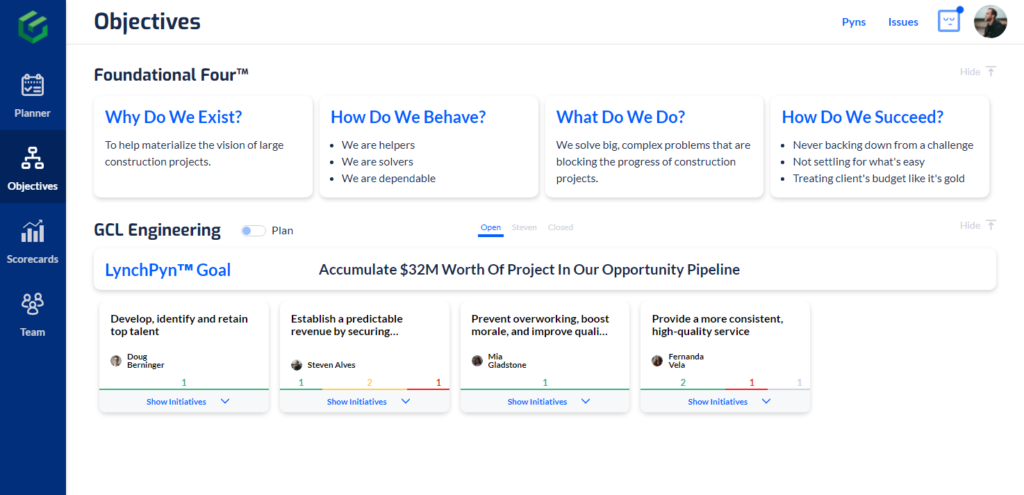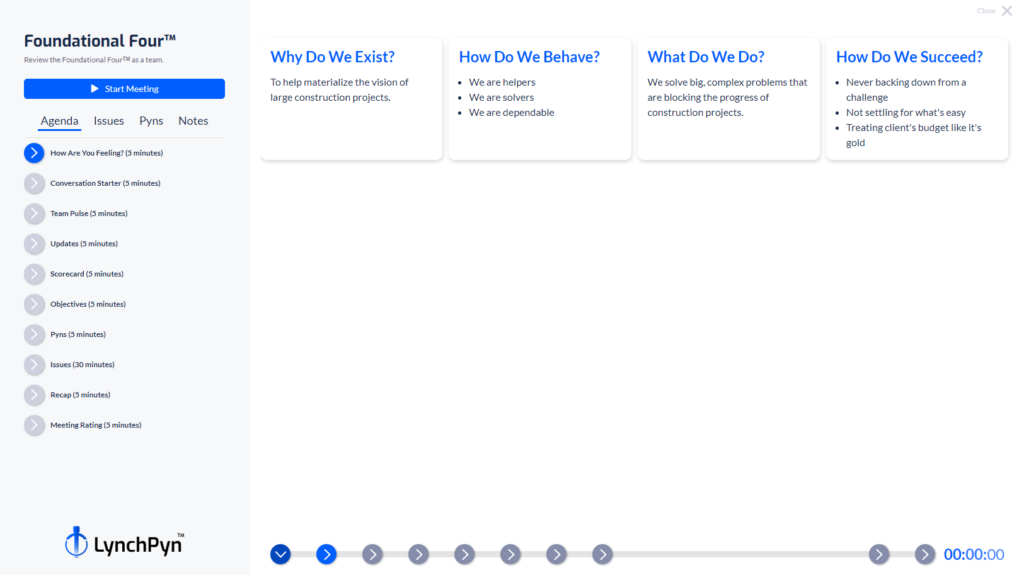Four Questions High Performing Teams Can Answer By Heart
Anthony DiMarco • November 11, 2021
Building High Performing teams is a timeless topic. A High Performing team is often the key reason behind a company’s success. And building one remains as tough as ever. Amid the myriad of sources of advice on how to form a High Performing team, I have found that alignment is the core characteristic that dictates the team dynamic and propels results.
They share a common grounding and are aligned on the direction and goals of the company. They understand how their work fits into the big picture. And they are aligned on who owns what.
“If you could get all the people in an organization rowing in the same direction, you could dominate any industry, in any market, against any competition, at any time.”
– Patrick Lencioni, Author of The Five Dysfunctions of a Team
Alignment means that everyone in the organization, from the leaders down to the front line, understands the company strategy and knows how their actions contribute to the overarching priorities. And it all starts with the leadership team.
| Misaligned companies… | Aligned companies… |
| Can’t hit the targets | Consistently execute and reach their targets |
| Lack of accountability and rely on blames and excuses |
Have clear accountability |
| Micromanage their employees | Support self-governance and autonomous decision-making |
| Have too many priorities | Focus on a few, committed priorities |
| Have disengaged employees | Have actively engaged employees |
Lack of alignment among the company leaders can be a source of great frustration for employees as they find themselves being pulled or misdirected in different directions. Even small discrepancies and misalignments between leadership team members can impact to employees’ performance and engagement level. And though most leaders recognize the importance of creating alignment, they often credit bad behavior or attitude for lack of it.
The first step in creating organizational alignment is defining your company strategy.
Strategic planning and defining company purpose and mission is a popular topic that has been discussed in great length, and we will not bore you with all the background. You probably already know most of it.
What is important to note here is that you need clarity around your strategy mainly because you need to focus your resources and energy on a playing field that gives you the greatest chance to win. When your strategy is defined (and communicated) with clarity, everyone within the company can use it as an anchor and a filter to make the right decisions.
“Strategy is only as good as your ability to articulate it, and clarity is an essential part of good leadership.”
– Bob Iger, former CEO of Walt Disney Company
In order to define your company’s strategy with clarity, you need to start by answering four foundational questions and define your playing field.

There are four questions that we have adapted from Patrick Lencioni’s The Advantage, which are universal and have been discussed in one way or another in other great business books. These four foundational questions will help you get clarity around your company and get on the same page:
1. Why do we exist?
This is your company’s underlying reason for being, and it is entirely idealistic. Everyone within your company needs to know that something grand and aspirational lies at the heart of what they do, beyond just making money. Someone in the world, your customer, the environment, the community, would be less if you didn’t exist.
2. How do we behave?
The set of core values that guide your behaviours and decisions over time, preserving the company’s essence. These are the few (just two or three) behavioural traits that are inherent in an organization. Core values help people know how they should behave when no one is looking. They lie at the heart of the company’s identity, do not change over time, and must already exist. A companies core values will attract the right people to an organization or repel who should never be on the team.
3. What do we do?
The simplest question. The answer is not idealistic whatsoever and is nothing more than a description of what the company does.
4. How will we succeed?
What sets you apart from others. What are the key strategic pillars that put you in a unique position to win. This is very much the core of your company’s strategy.
This may seem obvious, but to actually align your team and company, you have to communicate (and perhaps overcommunicate) your Foundational Four and LynchPyn Goal in a continuous, consistent manner.
The key to effective communication and creating alignment is shifting your perspective of strategy communication from an event that happens once every year or quarter to an ongoing practice that happens all the time and in many different ways. Having a PDF attached to your “All Staff” email once a year is not quite sufficient.
Here are a few communications approaches that will help you effectively communicate your strategy with your employees, create alignment around the organizational strategy, and deliver results.
Your business strategy should be publicly communicated and readily accessible to everyone in the company. It often helps to have a primary way of sharing your strategy. Still, everyone consumes information in different ways, and it’s useful to communicate strategy through a few different mediums to make sure your messages reach everyone.
Using a centralized source of truth that communicates your strategy in an easy-to-understand, visual manner will help your people internalize the business strategy. LynchPyn offers a home for your strategy that is always visible to your employees and makes it easy for them to understand it:

It can’t be stressed enough, but repetition is key. Repetition is often the difference between knowing and being left in the dark. The reality is that you need to communicate your strategy consistently, repeatedly, and with clarity to create alignment. That’s why we recommend to our clients to review their Foundational Four before every team meeting. It helps reiterate the message and, at the same time, ground everyone in the right context before any decision is made.
before every team meeting. It helps reiterate the message and, at the same time, ground everyone in the right context before any decision is made.

One of the key benefits of having a clearly defined strategy is that it will act as a filter and a decision-making anchor when an issue arises. You and your executive team are already leveraging this because you know your strategy by heart, but do your employees? Promoting your strategy as a tool and an anchor that everyone can leverage to prioritize better and make better decisions daily will improve alignment and reinforce cohesive company culture.
Articulating your strategy and communicating it is hard. You already know how important your people are to your business’s success and aligning them on company strategy and priorities is the first step in setting them up for success.
We built LynchPyn to help you communicate your plan to your team, get updates from them, and see how you’re progressing.